mobile View, to the German Version tap the flag


- Democratic People's Republic of Korea (North Korea)
- communist republic with one-party-system
- own name: Choson Minjujui Inmin Konghwaguk ("Korean People's Democratic Republic")
• Flags
• Historical Flag
• Meaning/Origin of the Flag
• Coat of Arms
• Meaning/Origin of the Coat of Arms
• Aircraft Roundel
• Map
• Numbers and Facts
• History
• Origin of the Country's Name
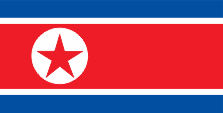
National, merchant and war flag,
ratio = 33:65,
Source, by: Wikipedia (D)





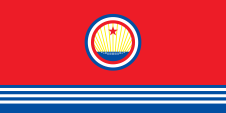
Naval war flag,
ratio = 33:65,
Source, by: FOTW



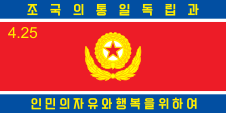
Flag of the army,
Source, by: Wikipedia (D)



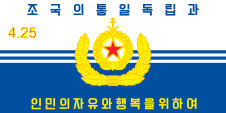
Flag of the navy,
Source, by: Wikipedia (D)



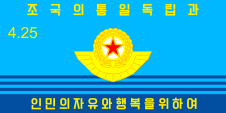
Flag of the air force,
Source, by: FOTW



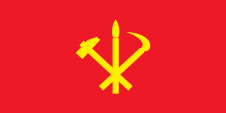
Flag of the Pary of Work of Korea (Workers' Party),
Source, by: Wikipedia (D)



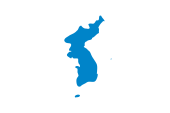
Flag of unification,
ratio = 2:3,
Source, by: By File:Unification flag of Korea (pre 2006).svg: Variousderivative work: Valentim (File:Unification flag of Korea (pre 2006).svg) [CC-BY-SA-3.0 or GFDL], via Wikimedia Commons




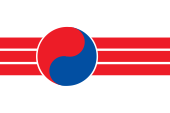
1945–1946,
Flag of the People's Republic of Korea,
ratio = 2:3,
Source, by: Wikipedia (EN),
Samhanin, Public domain, via Wikimedia Commons




The flag of North Korea shows five horizontal stripes in the colours blue, white, red, white, blue in the proportions 3:1:8:1:3. In the middle red stripe is positioned - displaced in direction of the flagstaff - a white disk with a red five-pointed star in it (symbol of the communism). The flag was officially introduced on the 8th of September in 1948. It was in significant parts created by incentives of the Great Leader Kim Il Sung. The colours blue and red are supposedly defined hexadecimally, as blue = #024fa2 and red = #ed1c27, from which the Pantone colours blue = pt 2945 and red = pt 1788 can be derived. The meaning of the colours of the flag knows the following interpretations:
• Red stands for communism; white stands for purity, strength, dignity and sovereignty; blue stands for hope and love for peace
• Red stands for the blood, which was given in the struggles for freedom and independence; white stands for the purity and unity of the nation; blue stands for the republic and the spirit of the people
• The flag symbolizes the position of North Korea between the Yellow Sea and the Sea of Japan
When this flag exactly appeared first is not known, probably in 1945. In preparation for the elections, which took place not before 1948, the Korean Workers' Party used not only the communist red party flags but also the Korean flag, like it is in use until today in South Korea. The "flag of unification" was used, among other opportunities, for the Winter Olympics 2018, when the teams of both Korea appeared under this common flag.
Source:
Die Welt der Flaggen,
Flaggen Wappen Hymnen,
Flaggen-Atlas Erde,
Wikipedia (D),
Wikipedia (EN)

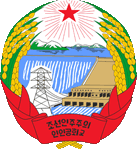
Coat of arms of North Korea,
Source: Corel Draw 4

The coat of arms of North Korea was like the flag introduced on the 8th of September in 1948 and shows a power station, a dam and a high voltage pole, below the glowing red star of communism, surrounded by rice ears. Those are holded together by a red banner with the name of the state in Hangul fonts: "Korean People's Democratic Republic". The substance of the coat of arms goes obviously back to a quotation of the Russian bolchevist Lenin: "Soviet power + elektrification = communism".
Source:
Die Welt der Flaggen,
Flaggen Wappen Hymnen,
Wappen und Flaggen aller Nationen

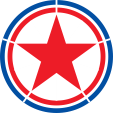
Aircraft Roundel,
Source, by: Wikipedia (EN)

Location:
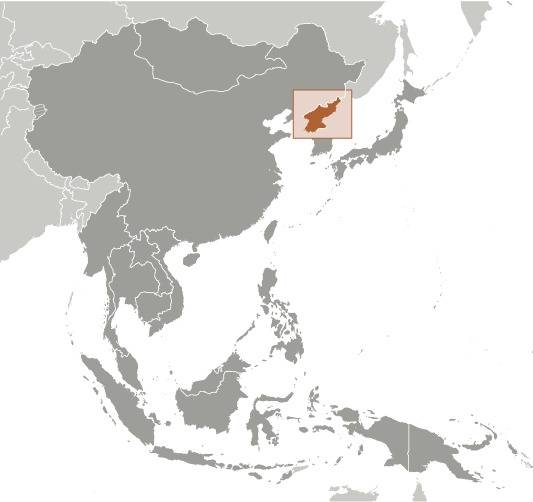
Source: CIA World Factbook
Map of the country:
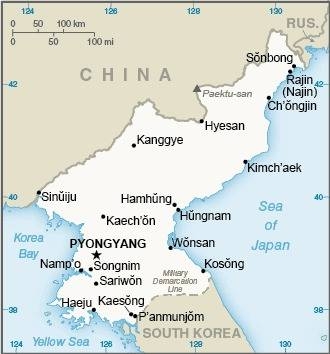
Source: CIA World Factbook

Area: 46.540 square miles
Inhabitants: 25.549.600 (2018), thereof 99% Koreans, 1% Chinese
Religions: 13% Chondoism, 12% Korean Shamanism, 2% Buddhist, 2% Christian, 71% Non-Religious
Density of Population: 212 inh./sq.mi.
Capital: Pjöngjang (Japanese: Heijo), 3.038.000 inh. (2018)
official Language: Korean
other Languages: Chinese
Currency: 1 Won (KPW, W) = 100 Chon
Time Zone: GMT + 9 h
Source:
Wikipedia (D), Wikipedia (EN)

ca. 1100 B.C. · establishment of the Korean state of Choson by Kitcha, the first king of the country and founder of the Kitcha-Dynasty
108 B.C. · subjection of Choson by China
194 B.C. · evolution of three Korean states in the south under the rule of the Chinese Han, in the north arises a Chinese vassal state
1st cent. B.C. · arise of three Korean independent kingdoms (Goguryeo, Baekje and Silla)
668 A.D. · the Kingdom of Silla joines all three kingdoms, but Silla disintegrates after 250 years in the empires Silla, Baekje and Madjin, wars between the empires, Madjin asserts oneself, unification of the empires under Madjin, Japan occupies transitionally a coastal stripe in the south (Karak country)
935 · General Wang Gon (Wang Kon) establishes in Madjin the Koryo-Dynasty, the united empire is named Koryo
1229 · Mongolian invasion, rule of the Mongols until 1280
1392 · enthronement of the Yi-Dynasty, which was established by General Yi Sungye (T'aejo), rename of the country in Choson
1592–1598 · Japan attempts to conquer Choson (Korea)
1637 · Choson (Korea) has to recognize the supremacy of the Chinese Mandju emperors, the country begins to insulate itself
1866 · French attempt to conquer the country
1871 · US-American attempt to conquer the country
1876 · Japan coerces the repeal of the isolation, opening of the ports for foreigner mights
1894–1895 · Chinese-Japanese War for the influence in Korea, China loses and has to recognize the Japanese supremacy in Korea
1904–1905 · Russian-Japanese Krieg for the influence in Korea, Russia succumbs
1910 · Japan annexes Korea as General Government of Chôsen (Choson), end of the Yi-Dynasty
1945 · end of the Second World War, Japan surrenders, Korea becomes partitioned alon the 38th degree of latitude, the north becomes occupied by the Soviet Union, the south by the USA
6th of September 1945 · In the Soviet occupation zone, the "People's Republic of Korea" is founded, whose powers were planned for the whole of Korea; in the South, all its activities are banned on 12.12.1945
8th of February 1946 · the "People's Republic of Korea" project is terminated
10th of May 1948 · elections in whole Korea for a employable government, North Korea boycotts the elections
July 1948 · new constitution for Korea
15th of August 1948 · in result of the election gets proclaimed (only in South Korea) the Republic of Korea
9th of November 1948 · in North Korea gets proclaimed the People's Democratic Republic of Korea
25th of June 1950 · North Korean troops invade South Korea, increase into a biger conflict in which embroil except South Korea even China the USA and respective allies
27th of July 1953 · Armistice of Panmundjom, the country remains separated along the armistice line between North and South Korea
1972 · Kim Il Sung becomes president of North Korea
1985 · small agreements between both Koreas
1990 · contacts of both Korean governments
1992 · „Treaty of reconciliation, non-aggression, interchange and cooperation“ between both Koreas, but increase of the tensions between both states
1993 · North Korea terminates the Nuclear Arms Block Treaty
1994 · death of Kim Il Sung, designated successor is his son Kim Jong Il
1996 · famine in North Korea
1997 · discussions about peace between North and South Korea under participation of the USA and China
1998 · Kim Il Sung gets declared as the Eternal President
from 2000 · diverse humanitarian improvements of the connections between both Koreas
2001 · famine in North Korea
from 2008 · deterioration in relations between the two Koreas
2012 · North Korea declares itself a nuclear power
from 2013 · improvement in relations between the two Koreas
Source:
Atlas zur Geschichte,
Wikipedia (D),
World Statesmen

The name "Korea" came to Europe in the middle ages by trading travelers. Either refered this designation to the Korean state of "Koguryo", which exists between the 1st cent. B.C. and the 7th cent. B.C. on the Korean peninsula, or the designation goes back to the dynasty "Koryo", which united the countries in the year 936 und gave the country "Koryo" its name. In the year 1392 the Dynastie "Yi" came to power (until 1910), which renamed the country in the same year in "Choson" (country of the morning freshness). This designation is in use until today by North Korea. South Korea names itself "Dachan Minkuk". But internationally is only in use Korea (North Korea or South Korea).
Source: Handbuch der geographischen Namen, Volker Preuß


![]()





























